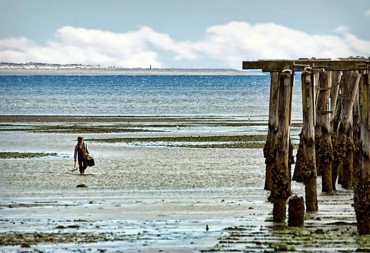
The oceans that surround us would really like to leave the Earth. Only Earth’s gravitational pull keeps them here. They are always seeking another gravitational pull with which to dance.
Our sun and moon are both willing partners. And dance they do.
The Earth rotates around the sun, making the focal point of the sun’s gravitational pull move as we spin. The much closer moon rotates around us; the focus of the moon’s gravitational pull also changes.
When the two pulls are in different directions, there’s not much of dance going on and tidal differences day to day are minimized. They are called “neap tides.”
But when the two tug in the same direction, the tidal dance can be huge. Huge enough to cause king tides.
King tide is the popular name; the name of the combined force that causes it is syzygy (pronounced sizz-uh-jee). Great word, eh? It generally occurs in December and January each year.
The next king tides are predicted for the weeks beginning Dec. 16, Jan. 12 and Feb. 10.
Now, add a powerful wind blowing over miles of open water, causing huge waves to build up, and we get a sort of super syzygy. And for us here on the South and West Sound, southerly winds blowing up Carr and Case inlets, and in Liberty Bay, Port Gamble, Hood Canal and other mostly enclosed bigger bays, along with the seiche effect of water moving in a shallow vessel, create conditions ripe for tidal flooding.
Puget Sound is a seiche (pronounced saysh). So are many of its South and West Sound bays. A seiche is a flat, shallow vessel filled with water that sways back and forth. If you fill a cookie sheet with water and carry it across a room, you create a seiche.
The water tends to slop over whichever end you tilt and it’s really difficult to get it to settle down. Puget Sound with its bays and inlets is no different. The gravitational pulls of the sun and the moon, combined with the rotation of the Earth, provide motion, like a tilt, for our seiche.
At high tide, water piles up like crazy at the far end of our long, shallow bays, most notably at Wauna (Purdy) on Carr Inlet and Allyn on Case Inlet. But also at Nisqually and at many other bays and inlets that make up the farthest boundaries of the main seiche, Puget Sound.
Tidal extremes in locations not at the ends of our seiche, for example at Seattle or Winslow, where the tide just passes by, are about 12 feet from lowest low to highest high during a king tide.
Meantime, Allyn and Wauna see predicted tidal differences of more than 20 feet, from minus 3.8 to plus 16.5 feet or more and a couple of feet more under winter storm conditions.
But wait, there’s more. One more force keeps our oceans from leaving the Earth. That’s atmospheric pressure. Air presses down on the oceans, helping keep them from springing into the sky.
At normal atmospheric pressure, a one-inch square column of air reaching into the ionosphere weighs around 14.7 pounds. Yes, that weighs on you all the time, too. It’s about as much as having a small car sit on you. But since it’s both inside and outside of you, it doesn’t crush you.
When atmospheric pressure goes down, as it typically does over Puget Sound during a storm, its ability to hold the sea down can be seriously affected. A barometric drop from 30 inches of mercury to 29 inches reduces that weight and results in a general tide level increase of 12.6 inches.
Add that extra foot to the syzygy the morning of, for example, Dec. 17, 2012, along with the gale force winds, and we had a greatly amplified high tide. The normal predicted high tide on that date measured in Seattle was one-fourth of an inch higher than the highest recorded high king tide in January of 1983. But many will remember that many low-lying areas near the Sound, including a number of public roads, flooded pretty significantly that day.
The next king tide for the Puget Sound area occurred the morning of Jan. 14, 2013. Winds were light and variable and barometric pressure was high, so the tides were nearly a foot lower than predicted, and the South and West Sound was as docile as a mill pond.
We live in a truly dynamic environment where gravity, wind, barometric pressure, the sun and the moon can change our mill pond into a roiling cauldron in a few hours.
As every mariner knows, we must be ever respectful of the forces of nature. We’d best be in awe.



























Comments